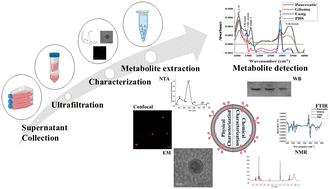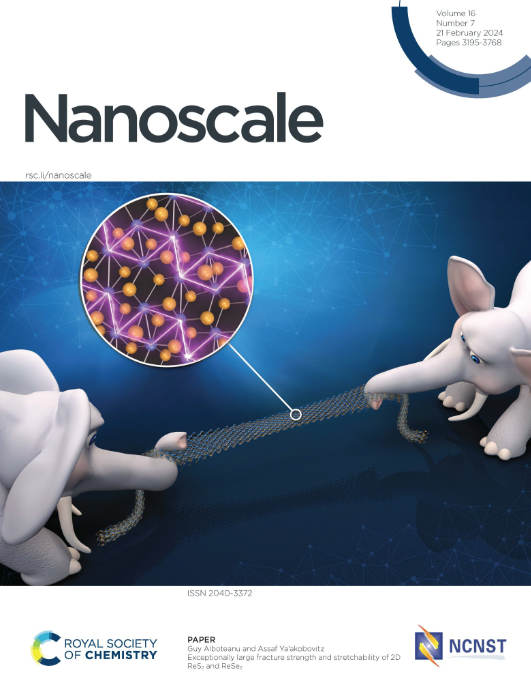Uncovering metabolic signatures in cancer-derived exosomes: LC-MS/MS and NMR profiling
IF 5.8
3区 材料科学
Q1 CHEMISTRY, MULTIDISCIPLINARY
引用次数: 0
Abstract
Understanding the intricate interplay between cancer metabolism and intercellular communication within the tumour microenvironment (TME) is crucial for advancing cancer diagnostics and therapeutics. In this study, we investigate the metabolites present in exosomes derived from three distinct cancer cell lines: pancreatic cancer (MiaPaCa-2), lung cancer (A549), and glioma (C6). Exosomes were isolated using ultrafiltration and characterized using a combination of techniques including nanoparticle tracking analysis (NTA), electron microscopy (EM), western blotting (WB) and Fourier-transform infrared (FTIR) spectroscopy. Leveraging state-of-the-art metabolomics techniques, including untargeted LC-MS/MS and NMR analyses, we elucidated the metabolic signatures encapsulated within cancer-derived exosomes. Notably, our investigation represents the first exploration of exosomal metabolites from pancreatic and glioma cells, addressing a significant gap in current knowledge. Furthermore, our study investigates the correlation between metabolites derived from different cancer cells, shedding light on potential metabolic interactions within the TME. Through comprehensive analyses, this study provides insights into dysregulated metabolic pathways driving cancer progression and offers novel perspectives on the diagnostic and therapeutic utility of exosomal metabolites. Importantly, common metabolites identified among cancer types suggest potential markers detectable by multiple techniques, enhancing their clinical applicability.

揭示癌症外泌体中的代谢特征:LC-MS/MS 和 NMR 分析
了解肿瘤微环境(TME)中癌症代谢与细胞间通讯之间错综复杂的相互作用对于促进癌症诊断和治疗至关重要。在这项研究中,我们调查了从胰腺癌(MiaPaCa-2)、肺癌(A549)和胶质瘤(C6)这三种不同癌细胞系中提取的外泌体中存在的代谢物。外泌体采用超滤技术分离,并通过纳米颗粒跟踪分析(NTA)、电子显微镜(EM)、西部印迹(WB)和傅立叶变换红外(FTIR)光谱等多种技术进行表征。利用最先进的代谢组学技术(包括非靶向 LC-MS/MS 和 NMR 分析),我们阐明了癌症外泌体中的代谢特征。值得注意的是,我们的研究是对胰腺癌和胶质瘤细胞外泌体代谢物的首次探索,填补了现有知识的一大空白。此外,我们的研究还探讨了来自不同癌细胞的代谢物之间的相关性,揭示了TME内潜在的代谢相互作用。通过综合分析,本研究深入了解了驱动癌症进展的失调代谢途径,并为外泌体代谢物的诊断和治疗作用提供了新的视角。重要的是,在不同癌症类型中发现的共同代谢物提出了可通过多种技术检测的潜在标记物,从而提高了它们的临床适用性。
本文章由计算机程序翻译,如有差异,请以英文原文为准。
求助全文
约1分钟内获得全文
求助全文
来源期刊

Nanoscale
CHEMISTRY, MULTIDISCIPLINARY-NANOSCIENCE & NANOTECHNOLOGY
CiteScore
12.10
自引率
3.00%
发文量
1628
审稿时长
1.6 months
期刊介绍:
Nanoscale is a high-impact international journal, publishing high-quality research across nanoscience and nanotechnology. Nanoscale publishes a full mix of research articles on experimental and theoretical work, including reviews, communications, and full papers.Highly interdisciplinary, this journal appeals to scientists, researchers and professionals interested in nanoscience and nanotechnology, quantum materials and quantum technology, including the areas of physics, chemistry, biology, medicine, materials, energy/environment, information technology, detection science, healthcare and drug discovery, and electronics.
 求助内容:
求助内容: 应助结果提醒方式:
应助结果提醒方式:


